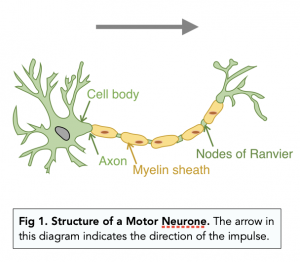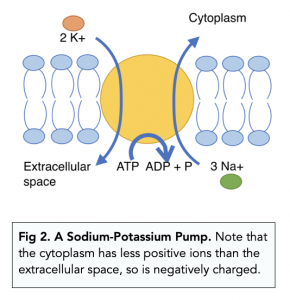The Resting Potential (A-level Biology)
The Resting Potential
Structure of Motor Neurone
Motor neurones carry impulses from the central nervous system to an effector (such as a muscle or gland), which coordinates the response to the stimulus.

- Dendrites – dendrites are thin extensions of the cell body that carry impulses received from neighbouring neurones to the cell body.
- Cell body – the cell body contains the nucleus, mitochondria, and many ribosomes.
- Axon – the axon is a long cytoplasmic extension that carries impulses away from the cell body. It is covered in Schwann cells, that surround and support the neurones.
- Myelin sheath – the layer of Schwann cells is known as the myelin sheath. It acts as an electrical insulator to speed up the rate of transmission.
- Nodes of Ranvier – these are gaps in the myelin sheath. They occur between adjacent Schwann cells.
Resting Potential
- Neurones are excitable cells, meaning that they can change their resting potential.
- The resting potential is the difference in charge across the neuronal membrane when the neurone is at rest. When neurones are at rest, the inside of the cell is more negative than the outside of the cell – this is caused by differences in ion concentrations and maintained by proteins called ion channels.
- This membrane is said to be polarised, due to the difference in charge. The voltage at resting potential is approximately -70mV.
Maintaining Resting Potential
The resting potential is established and maintained by three main factors:
- The membrane contains many sodium-potassium pumps. Sodium-potassium pumps use active transport to pump three sodium ions (Naᐩ) out of the neurone, and two potassium ions (Kᐩ) in. The membrane is not permeable to sodium ions, so they cannot diffuse back in, creating a sodium ion electrochemical gradient.

- Potassium ion channels make the membrane permeable to potassium ions. The channels allow Kᐩ ions to diffuse back out of the neurone, so they move from an area of high concentration (the cytoplasm) to an area of low concentration (extracellular space), increasing the positive charge outside.
- Anion concentrations are higher inside the neurone. Anions are large molecules with a negative charge, therefore increasing the electrochemical gradient of the membrane.
FAQs
The resting potential is the difference in electrical charge between the inside and outside of a cell when the cell is not actively transmitting an electrical signal.
The resting potential is created by the unequal distribution of ions, such as potassium (K+) and sodium (Na+), across the cell membrane. This unequal distribution leads to an electrical charge difference between the inside and outside of the cell.
The resting potential is essential for the proper functioning of cells and tissues, as it provides the electrical charge difference needed to initiate the transmission of electrical signals, also known as action potentials.
During an action potential, the resting potential changes as ions move rapidly in and out of the cell, resulting in a brief reversal of the electrical charge difference. This rapid change in charge allows the electrical signal to be transmitted along the length of the cell.
Ion channels play a crucial role in maintaining the resting potential by controlling the movement of ions in and out of the cell. These channels are specific to the type of ion being transported and are essential for the proper functioning of cells and tissues.
The resting potential can be altered in cells due to changes in the balance of ions across the cell membrane, changes in the permeability of the cell membrane, or changes in the activity of ion channels. These changes can have significant effects on the proper functioning of cells and tissues and can contribute to the development of diseases and disorders.






Still got a question? Leave a comment
Leave a comment